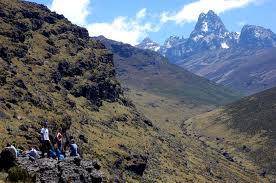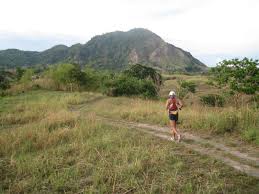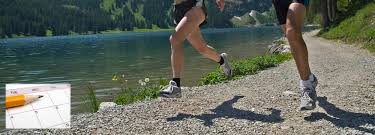|
Fitness
for Mt Kenya
Those who have made the trek to
its summit, however, know that Mt
Kenya Climb and Trekking it is one of
the most beautiful climbs in East Africa.
Better than Kilimanjaro, experience
an unforgettable trek to the 'roof'
of Kenya. Mt. Kenya towers over the
northeastern side of the Great Rift
Valley. Rainforest, bamboo, tarns, alpine
meadows, exotic high-altitude vegetation,
sunbirds, hyrax and soaring eagles make
a trek on this volcano one of the most
unique mountaineering experiences in
the world. Expert guides lead our group
up less-traveled routes, allowing adequate
time for acclimatizing and simply taking
in the view of the peaks!
 To
climb to Point Lenana on Mount Kenya
you don't need to be a super-fit athlete
nor and experienced mountaineer. The
trek is accessible to anyone with good
basic fitness and an ethusiasm for the
outdoors. It will be an advantage to
have good previous hill-walking experience
and therefore be familiar with walking
in the countryside for many hours at
a time. To
climb to Point Lenana on Mount Kenya
you don't need to be a super-fit athlete
nor and experienced mountaineer. The
trek is accessible to anyone with good
basic fitness and an ethusiasm for the
outdoors. It will be an advantage to
have good previous hill-walking experience
and therefore be familiar with walking
in the countryside for many hours at
a time.
You
will enjoy the trip all the more
if you do have good fitness and experience.
Therefore we do advise that on the lead
up to the trip you do spend time checking
and working on the kind of fitness that
you need for the trek. The ideal preparation
is spending a good number of hours walking
on rolling terrain with a small pack
of say 5kg on your back. Other forms
of cardio-vascular exercise such as
running, cycling and swimming will also
of course help with the right kinds
of fitness, though especially if they
focus mainly on the legs.
Type
of Terrain
The
paths vary as we ascend but they go
from a vehicle track lower down, to
a less defined path through tussocks
and bog, to a footpath over gravel and
mud and then sandy and dusty scree higher
up. On summit day there are a couple
of sections along the ridge where we
use hands aswell as feet but they are
very easy and the guides will help you
if you need it. There is also a steel
cable along most of teh final ridge
which although not by any means necessar,
is available for additional support.
The descents from Hut Tarn and Point
Lenana are over scree which can be dusty
and loose. We will take our time but
a trekking pole or two can be invaulable
for maintaining your balance. If you
have any problems with ankles, knees
or hips then poles are strongly reccommended
as well as a well-fitted support bandage.
Travel, Terrain, Etc...
TERRAIN/ROUTE CHOICES: Mt. Kenya
routes involve hiking 3-6 hours a day
over rough terrain. No technical climbing
is necessary to reach Pt. Lenana, Mt.
Kenya's 16,355 foot summit.
TYPE OF TRAVEL/DISTANCE: We
will use vehicles to transfer to and
from the mountain gate to Nanyuki or
naromoru and 4x4 on chogoria route.
You will hike throughout the trip covering
3-6 miles a day.
 WEATHER:
Mt. Kenya's climate is similar to other
mountain ranges across the globe. Although
unpredictable, there is typically warm
weather during the day (55-75ºF)
with clear skies in the morning and
clouds building up by afternoon. Temperatures
can fall to 20º F at night, especially
at the higher elevations. Rain or snow
is always a possibility. WEATHER:
Mt. Kenya's climate is similar to other
mountain ranges across the globe. Although
unpredictable, there is typically warm
weather during the day (55-75ºF)
with clear skies in the morning and
clouds building up by afternoon. Temperatures
can fall to 20º F at night, especially
at the higher elevations. Rain or snow
is always a possibility.
EQUIPMENT AND CLOTHING: All
you need to provide is personal gear,
such as clothing, sleeping bag, and
boots. A
detailed equipment list.
LEVEL OF DIFFICULTY: Previous
mountain climbing experience is not
necessary to climb Mt. Kenya, however
this is one of our most strenuous trips.
We do recommend that you do some fitness
training before this trip--the more
fit you are the more you will enjoy
the hike. Summiting Pt. Lenana is strenuous.
Approximately 70% of the people who
do this trip actually summit. The decision
to summit is solely the responsibility
of our guides. You will not summit if
our guide decides it would be unsafe
to do so.
HEALTH: It is important that
you make an appointment at least 4-6
weeks before your trip and inform your
doctor that you are traveling to Kenya.
This allows for adequate time to get
new immunizations, if required, and
ensure that others are up-to-date. Due
to the elevation, there is no risk of
contact with mosquitos and you will
not need anti-malarial medication for
this trip unless you will also be going
on a safari. Please talk to your doctor
about the risks of exercise at high
altitude as well. We also encourage
you to check the Center for Disease
Control and Prevention's website for
the most up-to-date recommendations.
ACCOMMODATIONS: Before and after
your trek you will stay in one of the
nice lodges or hotels in Nairobi and/or
the surrounding area. Most rooms are
double occupancy with two beds. Participants
will be paired by gender or requests
to room together. On the mountain, you
will camp out in tents or stay in one
of the very basic
huts found on the mountain.
Some participants choose to arrive
one or two days ahead of the start of
the trip to allow time for rest and
adjustment to the time change. Let us
know if you would like suggestions for
early-arrival lodging. If you arrive
on your own, taxi fare between the airport
and city hotels should be around 1800
Kenya shillings or 20$ .
 MEALS:
We will allow you bring own food. You'll
indulge in a mix of Kenyan cuisine and
typical hiking food like pasta and rice
dishes. We will use water from abundant
streams–it is very fresh but typically
we treat it just to be safe. The purchase
of alcoholic beverages is not included
in the trip fees. MEALS:
We will allow you bring own food. You'll
indulge in a mix of Kenyan cuisine and
typical hiking food like pasta and rice
dishes. We will use water from abundant
streams–it is very fresh but typically
we treat it just to be safe. The purchase
of alcoholic beverages is not included
in the trip fees.
PASSPORT/VISA: U.S. citizens
need a passport to enter Kenya, and
it must be valid for at least 6 months
beyond your planned departure. Two blank
passport pages (excluding the Amendments
pages) are typically required for entry
stamp and visa. U.S. citizens must obtain
an entry visa, which can be obtained
at the Nairobi airport for a fee of
approximately $50 USD or before traveling.
We encourage you to check the State
Department website for the most up-to-date
entry requirements: http://travel.state.gov/content/passports/english/country/kenya.html
You can get Visa on Nairobi airport
easy for 10-20 mins
Any
questions:Email:
info@mtkenyaguide.com
|